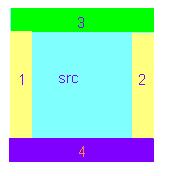上一篇文章,我们来给矩阵添加一些常用方法,这篇文章将讲解图像的虚拟边缘。
虚拟边缘
虚拟边缘就是按照一定映射关系,给图像添加边缘。
那么虚拟边缘有什么用呢?比如可以很容易做一个倒影的效果:

当然这只是附带效果了,虚拟边缘主要用在图像卷积运算(例如平滑操作)时候,由于卷积运算的特点,需要将图片扩大才能对边角进行卷积运算,这时候就需要对图片进行预处理,添加虚拟边缘。
说白了,就是在一些图片处理前进行预处理。
边缘类型
这里参考OpenCV相关文档的边缘描述:
/*
Various border types, image boundaries are denoted with '|'
* BORDER_REPLICATE: aaaaaa|abcdefgh|hhhhhhh
* BORDER_REFLECT: fedcba|abcdefgh|hgfedcb
* BORDER_REFLECT_101: gfedcb|abcdefgh|gfedcba
* BORDER_WRAP: cdefgh|abcdefgh|abcdefg
* BORDER_CONSTANT: iiiiii|abcdefgh|iiiiiii with some specified 'i'
*/
举个例子BODER_REFLECT就是对于某一行或某一列像素点:
abcdefgh
其左的虚拟边缘对应为fedcba,右边对应为hgfedcb,也就是反射映射。上图就是通过对图片底部进行添加BORDER_REFLECT类型的虚拟边缘得到的。
而BORDER_CONSTANT则是所有边缘都是固定值i。
实现
因为BORDER_CONSTANT比较特殊,所以和其他类型分开处理。
function copyMakeBorder(__src, __top, __left, __bottom, __right, __borderType, __value){
if(__src.type != "CV_RGBA"){
console.error("不支持类型!");
}
if(__borderType === CV_BORDER_CONSTANT){
return copyMakeConstBorder_8U(__src, __top, __left, __bottom, __right, __value);
}else{
return copyMakeBorder_8U(__src, __top, __left, __bottom, __right, __borderType);
}
};
这个函数接受一个输入矩阵src,每个方向要添加的像素大小top,left,bottom,right,边缘的类型borderType,还有一个数组value,即如果是常数边缘时候添加的常数值。
然后我们引入一个边缘的映射关系函数borderInterpolate。
function borderInterpolate(__p, __len, __borderType){
if(__p = __len){
switch(__borderType){
case CV_BORDER_REPLICATE:
__p = __p break;
case CV_BORDER_REFLECT:
case CV_BORDER_REFLECT_101:
var delta = __borderType == CV_BORDER_REFLECT_101;
if(__len == 1)
return 0;
do{
if(__p __p = -__p - 1 + delta;
else
__p = __len - 1 - (__p - __len) - delta;
}while(__p = __len)
break;
case CV_BORDER_WRAP:
if(__p __p -= ((__p - __len + 1) / __len) * __len;
if(__p >= __len)
__p %= __len;
break;
case CV_BORDER_CONSTANT:
__p = -1;
default:
error(arguments.callee, UNSPPORT_BORDER_TYPE/* {line} */);
}
}
return __p;
};
这个函数的意义是对于原长度为len的某一行或者某一列的虚拟像素点p(p一般是负数或者大于或等于该行原长度的数,负数则表示该行左边的像素点,大于或等于原长度则表示是右边的像素点),映射成这一行的哪一个像素点。我们拿CV_BORDER_REPLICATE分析一下,其表达式是:
__p = __p 也就是说p为负数时(也就是左边)的时候映射为0,否则映射成len - 1。
然后我们来实现copyMakeBorder_8U函数:
function copyMakeBorder_8U(__src, __top, __left, __bottom, __right, __borderType){
var i, j;
var width = __src.col,
height = __src.row;
var top = __top,
left = __left || __top,
right = __right || left,
bottom = __bottom || top,
dstWidth = width + left + right,
dstHeight = height + top + bottom,
borderType = borderType || CV_BORDER_REFLECT;
var buffer = new ArrayBuffer(dstHeight * dstWidth * 4),
tab = new Uint32Array(left + right);
for(i = 0; i tab[i] = borderInterpolate(i - left, width, __borderType);
}
for(i = 0; i tab[i + left] = borderInterpolate(width + i, width, __borderType);
}
var tempArray, data;
for(i = 0; i tempArray = new Uint32Array(buffer, (i + top) * dstWidth * 4, dstWidth);
data = new Uint32Array(__src.buffer, i * width * 4, width);
for(j = 0; j tempArray[j] = data[tab[j]];
for(j = 0; j tempArray[j + width + left] = data[tab[j + left]];
tempArray.set(data, left);
}
var allArray = new Uint32Array(buffer);
for(i = 0; i j = borderInterpolate(i - top, height, __borderType);
tempArray = new Uint32Array(buffer, i * dstWidth * 4, dstWidth);
tempArray.set(allArray.subarray((j + top) * dstWidth, (j + top + 1) * dstWidth));
}
for(i = 0; i j = borderInterpolate(i + height, height, __borderType);
tempArray = new Uint32Array(buffer, (i + top + height) * dstWidth * 4, dstWidth);
tempArray.set(allArray.subarray((j + top) * dstWidth, (j + top + 1) * dstWidth));
}
return new Mat(dstHeight, dstWidth, new Uint8ClampedArray(buffer));
}
这里需要解释下,边缘的复制顺序是:先对每行的左右进行扩展,然后在此基础上进行上下扩展,如图所示。

然后我们根据ArrayBuffer的性质,将数据转成无符号32位整数来操作,这样每个操作单位就对应了每个像素点了。什么意思?
比如对于某个像素点:RGBA,由于某个通道是用无符号8为整数来存储的,所以实际上一个像素点则对应了32位的存储大小,由于ArrayBuffer的性质,可以将数据转成任意类型来处理,这样我们就可以通过转成Uint32Array类型,将数据变成每个像素点的数据数组。
那么copyMakeConstBorder_8U就比较容易实现了:
function copyMakeConstBorder_8U(__src, __top, __left, __bottom, __right, __value){
var i, j;
var width = __src.col,
height = __src.row;
var top = __top,
left = __left || __top,
right = __right || left,
bottom = __bottom || top,
dstWidth = width + left + right,
dstHeight = height + top + bottom,
value = __value || [0, 0, 0, 255];
var constBuf = new ArrayBuffer(dstWidth * 4),
constArray = new Uint8ClampedArray(constBuf);
buffer = new ArrayBuffer(dstHeight * dstWidth * 4);
for(i = 0; i for( j = 0; j constArray[i * 4 + j] = value[j];
}
}
constArray = new Uint32Array(constBuf);
var tempArray;
for(i = 0; i tempArray = new Uint32Array(buffer, (i + top) * dstWidth * 4, left);
tempArray.set(constArray.subarray(0, left));
tempArray = new Uint32Array(buffer, ((i + top + 1) * dstWidth - right) * 4, right);
tempArray.set(constArray.subarray(0, right));
tempArray = new Uint32Array(buffer, ((i + top) * dstWidth + left) * 4, width);
tempArray.set(new Uint32Array(__src.buffer, i * width * 4, width));
}
for(i = 0; i tempArray = new Uint32Array(buffer, i * dstWidth * 4, dstWidth);
tempArray.set(constArray);
}
for(i = 0; i tempArray = new Uint32Array(buffer, (i + top + height) * dstWidth * 4, dstWidth);
tempArray.set(constArray);
}
return new Mat(dstHeight, dstWidth, new Uint8ClampedArray(buffer));
}
效果图
CV_BORDER_REPLICATE

CV_BORDER_REFLECT

CV_BORDER_WRAP

CV_BORDER_CONSTANT

 JavaScript Engines: Comparing ImplementationsApr 13, 2025 am 12:05 AM
JavaScript Engines: Comparing ImplementationsApr 13, 2025 am 12:05 AMDifferent JavaScript engines have different effects when parsing and executing JavaScript code, because the implementation principles and optimization strategies of each engine differ. 1. Lexical analysis: convert source code into lexical unit. 2. Grammar analysis: Generate an abstract syntax tree. 3. Optimization and compilation: Generate machine code through the JIT compiler. 4. Execute: Run the machine code. V8 engine optimizes through instant compilation and hidden class, SpiderMonkey uses a type inference system, resulting in different performance performance on the same code.
 Beyond the Browser: JavaScript in the Real WorldApr 12, 2025 am 12:06 AM
Beyond the Browser: JavaScript in the Real WorldApr 12, 2025 am 12:06 AMJavaScript's applications in the real world include server-side programming, mobile application development and Internet of Things control: 1. Server-side programming is realized through Node.js, suitable for high concurrent request processing. 2. Mobile application development is carried out through ReactNative and supports cross-platform deployment. 3. Used for IoT device control through Johnny-Five library, suitable for hardware interaction.
 Building a Multi-Tenant SaaS Application with Next.js (Backend Integration)Apr 11, 2025 am 08:23 AM
Building a Multi-Tenant SaaS Application with Next.js (Backend Integration)Apr 11, 2025 am 08:23 AMI built a functional multi-tenant SaaS application (an EdTech app) with your everyday tech tool and you can do the same. First, what’s a multi-tenant SaaS application? Multi-tenant SaaS applications let you serve multiple customers from a sing
 How to Build a Multi-Tenant SaaS Application with Next.js (Frontend Integration)Apr 11, 2025 am 08:22 AM
How to Build a Multi-Tenant SaaS Application with Next.js (Frontend Integration)Apr 11, 2025 am 08:22 AMThis article demonstrates frontend integration with a backend secured by Permit, building a functional EdTech SaaS application using Next.js. The frontend fetches user permissions to control UI visibility and ensures API requests adhere to role-base
 JavaScript: Exploring the Versatility of a Web LanguageApr 11, 2025 am 12:01 AM
JavaScript: Exploring the Versatility of a Web LanguageApr 11, 2025 am 12:01 AMJavaScript is the core language of modern web development and is widely used for its diversity and flexibility. 1) Front-end development: build dynamic web pages and single-page applications through DOM operations and modern frameworks (such as React, Vue.js, Angular). 2) Server-side development: Node.js uses a non-blocking I/O model to handle high concurrency and real-time applications. 3) Mobile and desktop application development: cross-platform development is realized through ReactNative and Electron to improve development efficiency.
 The Evolution of JavaScript: Current Trends and Future ProspectsApr 10, 2025 am 09:33 AM
The Evolution of JavaScript: Current Trends and Future ProspectsApr 10, 2025 am 09:33 AMThe latest trends in JavaScript include the rise of TypeScript, the popularity of modern frameworks and libraries, and the application of WebAssembly. Future prospects cover more powerful type systems, the development of server-side JavaScript, the expansion of artificial intelligence and machine learning, and the potential of IoT and edge computing.
 Demystifying JavaScript: What It Does and Why It MattersApr 09, 2025 am 12:07 AM
Demystifying JavaScript: What It Does and Why It MattersApr 09, 2025 am 12:07 AMJavaScript is the cornerstone of modern web development, and its main functions include event-driven programming, dynamic content generation and asynchronous programming. 1) Event-driven programming allows web pages to change dynamically according to user operations. 2) Dynamic content generation allows page content to be adjusted according to conditions. 3) Asynchronous programming ensures that the user interface is not blocked. JavaScript is widely used in web interaction, single-page application and server-side development, greatly improving the flexibility of user experience and cross-platform development.
 Is Python or JavaScript better?Apr 06, 2025 am 12:14 AM
Is Python or JavaScript better?Apr 06, 2025 am 12:14 AMPython is more suitable for data science and machine learning, while JavaScript is more suitable for front-end and full-stack development. 1. Python is known for its concise syntax and rich library ecosystem, and is suitable for data analysis and web development. 2. JavaScript is the core of front-end development. Node.js supports server-side programming and is suitable for full-stack development.


Hot AI Tools

Undresser.AI Undress
AI-powered app for creating realistic nude photos

AI Clothes Remover
Online AI tool for removing clothes from photos.

Undress AI Tool
Undress images for free

Clothoff.io
AI clothes remover

AI Hentai Generator
Generate AI Hentai for free.

Hot Article

Hot Tools

SecLists
SecLists is the ultimate security tester's companion. It is a collection of various types of lists that are frequently used during security assessments, all in one place. SecLists helps make security testing more efficient and productive by conveniently providing all the lists a security tester might need. List types include usernames, passwords, URLs, fuzzing payloads, sensitive data patterns, web shells, and more. The tester can simply pull this repository onto a new test machine and he will have access to every type of list he needs.

PhpStorm Mac version
The latest (2018.2.1) professional PHP integrated development tool

SAP NetWeaver Server Adapter for Eclipse
Integrate Eclipse with SAP NetWeaver application server.

DVWA
Damn Vulnerable Web App (DVWA) is a PHP/MySQL web application that is very vulnerable. Its main goals are to be an aid for security professionals to test their skills and tools in a legal environment, to help web developers better understand the process of securing web applications, and to help teachers/students teach/learn in a classroom environment Web application security. The goal of DVWA is to practice some of the most common web vulnerabilities through a simple and straightforward interface, with varying degrees of difficulty. Please note that this software

SublimeText3 Mac version
God-level code editing software (SublimeText3)





